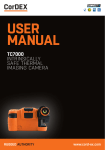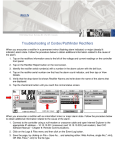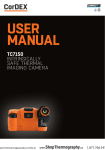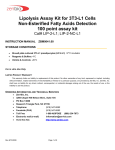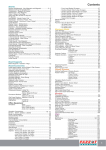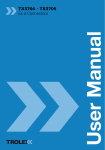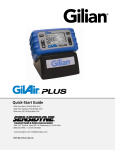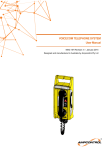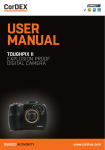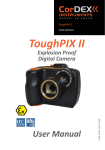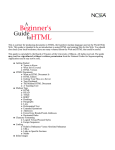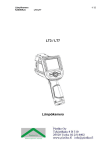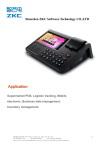Download USER MANUAL - CorDEX Instruments
Transcript
USER MANUAL TC7000/TC7150 INTRINSICALLY SAFE THERMAL IMAGING CAMERA RUGGED AUTHORITY www.cord-ex.com Congratulations – You are the owner of the first fully radiometric thermal imaging camera designed and certified specifically for use in hazardous (explosive) atmospheres. Your CorDEX intrinsically safe thermal imaging is ATEX, IECEx and NRTL certified. For specific certification levels and Special Considerations for Safe Use, refer to the latest revisions of Manuals; TC7000SOM and TC7150SOM. If in doubt, contact your local CorDEX Instruments Representative. ! Please ensure that the certification matches or exceeds the hazardous area characteristics that will be clearly displayed on site. ! Whilst in a hazardous area, do not attempt to change batteries or download images, these tasks should only be undertaken after returning to a safe area. CONTENTS Getting To Know Your Infrared Camera 4 Getting Started 6 A Guide To Charging Your Infrared Camera 7 A Guide To Your Home Screen 8 Focus 9 Creating A Thermal Image 9 Menu Selection 11 RFID 12 Analysis 13 Settings 14 Parameters 15 Level/Span 16 Storing And Analysing Images 17 Technical Information 18 Ten Suggestions For Thermography Best Practice 19 TC7000/TC7150 – User Manual GETTING TO KNOW YOUR INFRARED CAMERA 2 1 3 1 1 6 9 4 7 5 8 6 4 2 5 1 Neck Strap Points 2 RFID Scanner 3 Focus Ring Focus Ring RUGGED AUTHORITY 4 1 Wrist Strap Points 5 Image Save 2 USB Connection Point 6 Power Switch 3 135˚ Swivel Lens View Key 4 Menu Key 5 Span + 6 Span - 3 4 7 Level + 8 Level 9 Joystick 135˚ Swivel Lens Document Reference TC7000/TC7150UM Rev. B 5 TC7000/TC7150 – User Manual GETTING STARTED A GUIDE TO CHARGING YOUR INFRARED CAMERA 1 4 1 7 Check the contents of your Infrared Camera. The shipping case should include the following items: For comparative thermography, do not amend the emissivity setting and leave this constant every time you carry out imaging. Temperature differences over time will then be valid although the ambient temperature may have changed as well as the electrical or mechanical load of the object. Remove the battery from the battery compartment of the camera. Insert the battery pack into the camera paying careful attention to the orientation of the pack. 2 8 Plug the mains charging unit to a mains circuit and plug the jack from the charging unit into the battery station. Remove battery when the camera is no longer in use. DO NOT REMOVE BATTERY WHILST IN HAZARDOUS AREA. • TC7000/TC7150 Thermal Imaging Camera • USB Communication Wand • Manual Pack • Certificate of Conformity • Neck Strap • Rechargeable Battery Pack • Lens Cleaner • Wrist Strap • Access key 5 3 For accurate thermal measurement the emissivity of the object will need to be considered and the camera emissivity setting corrected. In addition background and reflected ambient will need to be considered as well as thermal and solar reflection and relative humidity. • Battery Charging Station and Mains Charging unit 3 Before using Infrared Camera consider the objects that you are going to image. Will you use comparative thermography (simply looking for temperature difference) or are you going to attempt to make an accurate temperature measurement? RUGGED AUTHORITY 1 Rechargeable/Removable Battery 2 Mains Charging Unit 3 Battery Charging Station 4 2 Please ensure that you fully charge the battery prior to use. The battery is charged using the docking station supplied. (See page 7.) Insert the battery into the battery charging compartment on the battery charging station. A green light will show that the unit has power. The charging light on the charging unit will flash amber whilst the charger assesses the charge held on the battery. Following this a solid amber light will be displayed showing that the unit is charging. When the amber light is no longer displayed, the battery is fully charged. ! Please Note: It is recommended that users attend formal thermography training to understand the implication of these parameters. 5 2 1 Remove the battery from the charging compartment. 6 Insert the battery pack into the camera paying careful attention to the orientation of the pack. 3 Document Reference TC7000/TC7150UM Rev. B 7 TC7000/TC7150 – User Manual A GUIDE TO YOUR HOME SCREEN FOCUS 1 4 1 RFID Tag Status Bar 2 Temperature Reading Spot #1 2 3 Temperature Spot #1 3 5 4 SPAN upper limit CAPTURING A THERMAL IMAGE 6 5 Temperature Scale 6 SPAN lower limit 7 Battery Charge Indicator 8 Ambient Temperature Selected 9 Reflected Temperature Selected 10 Relative Humidity Selected 11 Emissivity Selected 12 IW Series IR Window Correction enabled icon RUGGED AUTHORITY 12 11 10 9 • Correct focus is critical in producing an effective thermal image. Slowly rotate the knurled orange Focus Ring on the front of the lens until the object is clearly in view. You may find that the best focus is easier to achieve using a grey scale palette. Make sure that you focus on the object to be measured rather than the background. 8 7 • Switch on the Infrared Camera by pressing and holding the power switch for at least 3 seconds. • Ensure auto Level/Span is enabled. (See Settings section on P.13) • Ensure that camera is correctly focused. • You should now see a high quality thermal image and be able to discern small spatial and temperature differences. • Spots (crosshairs) can be moved by using the joystick. The temperature at that point is displayed on the top left of the display. When the crosshair is highlighted, pressing and holding the joystick will allow the emissivity of that spot only to be changed. Document Reference TC7000/TC7150UM Rev. B 9 TC7000/TC7150 – User Manual MENU SELECTION • Pressing the joystick again will highlight each spot in turn. This is followed by the option for the Infrared Camera to scan for an RFID tag. Place the top front of the camera within 5 cm of an RFID tag and press/hold the joystick again. The RFID tag information will be displayed and can be edited. (See detailed RFID Section on P.11) • All other camera settings and features are selected through the menu button. Press this once to display 6 icons. • The settings icon enables the user to select or deselect all of the display settings. (See detailed Settings section on P.13) • When the NUC icon is highlighted one press of the joystick will perform a manual Non Uniformity Correction (NUC). This should not be required in normal use as the NUC is carried out automatically when required. A distinct click will be heard when the NUC is performed and the thermal image will be refreshed. A manual NUC may be required when moving to different ambient temperatures but very frequent NUC operation will seriously impact battery life. • The parameters icon allows measurement parameters to be altered. These include ambient temperature, reflected temperature, relative humidity and target distance. Note that emmisivity adjustment is selected individually at each spot measurement. (See detailed parameters section on P.14) • When the analysis icon is highlighted pressing the joystick in will cycle through crosshair (spot) selection (0,1,2 or 3), maximum temperature display (within entire image), minimum temperature display (within entire image). (See detailed analysis section on P.12) RUGGED AUTHORITY • The clock icon enables setting of all time and date information. • The info icon displays camera serial number, internal memory used, remaining internal memory and battery capacity. Document Reference TC7000/TC7150UM Rev. B 11 TC7000/TC7150 – User Manual RFID ANALYSIS • When an RFID tag is located an RFID details menu will be displayed which shows the hexadecimal identification of the RFID tag. • It is recommended that an alias is then added for future identification the tag location . Use the joystick to highlight the alias section (complete with selecting OK) and then input a simple description through the qwerty options (complete with selecting OK - this can be edited later in CorDEX CONNECT) • Select whether the RFID Tag is built into a CorDEX IR window (IW2000, IW3000, IW4000) or if it is a stand alone tag (NON CDX). • With the RFID tag editing complete select SAVE to store this information for future use. The analysis menu is split into two sections; Spots and Isotherms. Selecting Spots enables live spot measurement mode with three options. Selecting Isotherms enables live isotherm analysis. 1 There are two options; Upper and Lower, each option having a colour and temperature selection. The No. spots icon allows choice of 0, 1, 2 or 3 temperature spots (crosshairs) within the display that will update in real time 2 The Hi icon enables and disables display of maximum temperature within the image as a red spot (crosshair). This temperature will be the same as the top of the temperature range in auto span/level. 3 The Lo icon enables and disables display of minimum temperature within the image as a blue spot (crosshair) This temperature will be the same as the bottom of the temperature range in auto span/level. RUGGED AUTHORITY 1 2 Selecting “Upper” will saturate any temperature greater than the temperature selected below this option with colour selected below this option. 3 Selecting “Lower” will saturate any temperature lower than the temperature selected below this option with colour selected below this option. NOTE to better. Use images ANALYSIS.jpeg & ISOTHERM.jpeg in this updated section. Document Reference TC7000/TC7150UM Rev. B 13 TC7000/TC7150 – User Manual SETTINGS PARAMETERS There are 12 icons in the Settings Menu 11 1 The Periodic Save Icon allows the user to set the camera to automatically save an image every 10 seconds, 30 seconds or one minute. (This is the same as pressing the image save button on the camera) The Scale Icon toggles the display of the temperature colour scale. 2 12 The Info Fields Icon allows display of relative humidity only, reference and ambient temperatures only, emissivity only or all. Edit RFID. This function allows you to edit the RFID information as you save an image 3 To Save battery life the Auto Off Icon allows a choice of 2, 5 or 10 minutes of no activity before auto off. The off setting disables this feature. 4 The Auto S/L Icon toggles between enabling the auto span and level setting where highest and lowest temperatures seen within the image are always displayed and manual level and span where the user can manually select span and level to adjust displayed temperature range. The Text Tag Icon enables and disables text annotation when saving files. There are 5 icons in the parameters menu all allowing the user to input temperature measurement parameters to increase measurement accuracy. 8 1 The Palette Icon allows the user to choose between greyscale (black hot), greyscale (white hot), ironbow, hotmetal, rainbow, amber and sepia colour palettes. The Amb Temp Icon accepts input of object ambient temperature. 7 9 2 The Atmos Temp Icon accepts input of atmospheric temperature. The Temperature Units Icon allows the user to choose either Celsius, Fahrenheit or Kelvin temperature display 3 The Voice Tag Icon enables and disables voice annotation when saving files. 10 4 6 The Temperature Units Icon allows the user to choose either Celsius, Fahrenheit or Kelvin temperature display The Target Dist Icon accepts input of camera distance from target object. 5 Brightness Adjustment. Select the backlight brightness in Levels 1 – 8. Level 1 being the lowest and level 8 being the highest. RUGGED AUTHORITY The Rel Humidity Icon accepts input of relative humidity. Document Reference TC7000/TC7150UM Rev. B 15 TC7000/TC7150 – User Manual PARAMETERS CONTINUED LEVEL/SPAN STORING AND ANALYSING IMAGES • Two settings are fundamental to obtaining an effective thermal image, the first is clear focus and the second is the correct thermal range which is adjusted by Level and Span Settings. • The Image Save Button on top of the handgrip is used to store images (except when periodic save is enabled). • With Auto Level and Span enabled in the Settings Menu the range is automatically adjusted to display both the hottest and coldest temperature within the field of view. Moving a spot and setting its emissivity 3. There are three measurement spot options made available within your camera. Each spot has an individual measurement function as the target material between spots maybe different. To access and adjust the individual spot location and emissivity; When the spot is located in the correct position, press and hold the joystick for 3 second and the emissivity setting will appear in grey adjacent to the spot. To alter the Spot emissivity move the joystick left and right. The value can be set from 0.3 – 1.0 in 0.01 increments. To accept the adjustment, press the joystick in once more. 1. In the live view mode, momentarily press the Joystick until the spot you want to adjust is highlighted in green at the top of the display. 2. To move the spot to the desired location on the screen use the joystick. RUGGED AUTHORITY • When more sensitivity is required level and span must be set manually by disabling auto level/span in the Settings Menu and using the L+/Land S+/S- buttons on the rear of the camera. Start by increasing the span (sensitivity) to the required setting and then increase or decrease the level (range) so that the object is visible at the required sensitivity. • When you want to save an image, press the Image Save Button and a Save Image menu will appear. Use the joystick to select yes and press joystick to save. • If RFID scan is enabled in the Settings Menu you will be asked to scan an RFID tag to link the saved image to a location. • If text annotation is enabled in the Settings Menu you will be asked to select one of 4 pre-programmed text comments. After this the image is stored in the camera memory. • If voice annotation is enabled in the Settings Menu you will be asked to record your message. Press the joystick on the Record Button, speak (maximum ten seconds) and then press the joystick on the Stop Button to finish. • To review saved images within the camera press VIEW on the rear of the camera and use the joystick to select the image required. Pressing the joystick will display the stored image full size on the camera display showing all of the parameters displayed when the image was saved. Moving the joystick up and down will change the display colour palette. Document Reference TC7000/TC7150UM Rev. B 17 TC7000/TC7150 – User Manual Certificate Information ATEX / IECEx Certificate No TRAC12ATEX0037X / IECEx TRC 12.0019X ATEX / IECEx Certificate Types • • • MET Listing No E113607 MET (North American) Certificate Type Class I, Division 2 Class II, DIvision 2 Class III Ex ib IIC T4 Gb Tamb -10°C to +40°C (Vapor) Ex ib IIIC T200°C Db Tamb -10°C to +40°C (Dust) Ex ib I Mb (Mining) Temperature Information Measurement Range -4°F to 1112°F (-20°C to +600°C ) Accuracy ± 2°C or 2% of reading Imaging Image Frequency 9Hz Detector 320 x 240 uncooled microbolometer Thermal Sensitivity/NETD 50mK Spectral Range 8μm to 14μm Field of View (FOV) 25° x 20.5° Spatial resolution (IFOV) 1.38 mrad Minimum focus distance ≈ 4” (10cm) Lens F 1.2 Image Capture File Storage 8GB File Formats CDX (Radiometric) JPEG (Non-radiometric) Voice Annotation YES RFID Tag Reader • • • Operates with 13.54MHz passive tags Detection range up to 5cm (1.9in) SupportsISO/IEC15693-2,ISO/IEC18000-3 tag formats General Operating Temperature -4°F to 104°F (-20°C to +40°C) Storage Temperature -40°F to +158°F (-40°C to +70°C) Display 3.2” Backlit LCD Software CorDEX CONNECT (Included) Batteries Removable and Rechargeable Battery Life Upto 8 hours RUGGED AUTHORITY TEN SUGGESTIONS FOR THERMOGRAPHY BEST PRACTICE 1 5 Ensure that the electrical or mechanical system you are imaging is running fully loaded to highlight thermal anomalies. A fully loaded system will generate higher temperature differential making it simpler to identify problems. Observe a scene from different angles to minimise thermal reflection as an unusual warm area could just be your own thermal reflection. Minimise solar reflection on display screens outdoors by changing your stance or swivelling the lens to eliminate reflection. 2 6 Ensure your image is in focus – this is important not only for image clarity but also accurate temperature discrimination and measurement. Focus should always be set to the object being measured even if this means that a surrounding area may be out of focus. Always consider the object emissivity first if you want to come close to an accurate temperature measurement, but remember that regular comparative thermography will also show temperature changes leading to potential failure. 3 7 If working in a Zone 1 Hazardous area, ensure that your thermal imaging camera is marked with the appropriate certification to avoid risk of explosion. Employers are required to identify hazardous areas clearly for both employees and contractors. For comparative thermography, ensure that thermal camera settings and especially emissivity remain consistent. Ideally system load should also be similar although this is often impractical. 4 If you are looking for temperatures above or below a temperature threshold, use an isotherm or maximum temperature within an area feature to clearly highlight any excess. These features save time and increase awareness as surveys can take several hours where fatigue could cause an important anomaly to be overlooked. 8 Use infrared windows to image electrical switchgear under full load in safety. Never open cabinet doors or override protection devices, this will put you at serious risk of injury from arc flash. Even a change of airflow or dust and debris being dislodged can trigger an arc flash incident. Document Reference TC7000/TC7150UM Rev. B 19 TC7000/TC7150 – User Manual 9 Always store images and relate them where possible to visible images when building a Report. This makes it easier to pinpoint the fault for scheduled maintenance. Choose a reporting software package that makes this process simple and consider installing RFID tags to link measurements from different technologies to one specific location. 10 Report critical items separately in the Report and draw attention to them clearly – the whole idea of thermography for preventive maintenance is to find faults and fix them before they cause a breakdown and loss of production or uptime. Choose a report software package that creates a scheduled job sheet to pass straight to the maintenance engineer. RUGGED AUTHORITY Document Reference TC7000/TC7150UM Rev. B 21 TC7000/TC7150 – User Manual RUGGED AUTHORITY Document Reference TC7000/TC7150UM Rev. B 23 Copyright © 2015, CorDEX Instruments Limited. All other brand and product names are trademarks of CorDEX Instruments Limited. Document Reference TC7000/TC7150UM Rev. B













